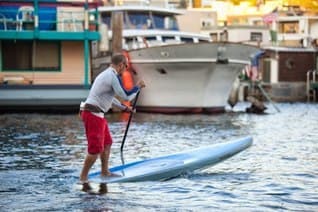How to do the Pivot Turn for SUP
By Rob Casey
reprinted with permission from: Stoke Magazine
One of the most talked about and frustrating SUP techniques is the Pivot Turn. If you're racing you may need to use it to go around buoys in a hurry. I use is in surf to turn quickly to catch waves and get back out after a ride before the next wave comes in.
With friends and students, we also practice it often to see how high we can get the board out of the water before falling in.

Most Common Errors:
- Taking paddle blade out of the water after each stroke.
- Not bending knees.
- Stalling the paddle to regain balance.
- Not practicing enough.
- Over use of the pivot turn for buoy turns. It's not always the best way around.
Safety Tips:
- Practice in deep water so you don't land on something.
- Don't fall with the board facing another paddler or dock - it'll shoot out!
- Fall flat on water spread eagle (or Hi-C plunge) style. This will prevent you from landing feet first on something underneath.
- Dress for immersion. It's more fun to fall if you're comfortable with the water temp.
- Use a leash to prevent board from getting away from you when falling. It will shoot out!
Step by Step Technique:
- Surf style boards technique below.
Longer boards to 17 feet or longer require walking back further to get the nose out.
- Stand in middle of board with both feet facing forward (non surf stance).
- Place your paddle blade flat (power face up - back of paddle flat on surface) in the water next to you (middle of board). This provides stability.
- Keeping blade flat on water at your side, slide or step one foot behind you about 6 inches. Then slide your other foot back parallel to the first.
- Do this one more time - 6" (approx) for first, then second foot. Notice how your board nose rises out of the water.
- Keeping knees slightly bent, begin to turn the board with a forward or reverse sweep turn (side turn). Use a Sweeping Brace on your recovery back to the catch or nose of the board. Spin the board in a 360. Switch hands and try on the other side.
Balance Tip:
After you take a stroke, instead of taking the blade out of the water - rotate so it slides flat on the surface with the power face up (this is the Sweeping Brace) back to your starting point (catch) for the next stroke. I use this regularly especially in bumpy water or surf. [Video above shows examples of the Sweeping Brace]
- With blade on water flat - Step one foot back another 6" or so rising the nose out further. Stay in this position, also called Surfer's Stance. Make sure each foot is on opposite sides of the center line. Bend you knees more to a squat (Note: lean into board as it raises out of the water). - Do the turn again, making sure to keep the blade flat on the water power face up during your recovery. If you rest, keep blade flat on water. Taking it out to waist level means a swim.
Feeling tippy? Don't stall! Keep your paddle blade moving - either turning, or sweeping across surface of water. Stay low too - don't raise your paddle above your head looking for stability. Staying low is more stable than rising up. In unstable water note how surfers and river paddlers stay low.
Now try to walk back further raising nose higher. The higher it goes the quicker you need to paddle and recover with the sweeping brace. Stay loose, knees bent, no stalling.
Recover by walking back to the center of the board (handle) by staying low but paddling forward as you walk forward. Like riding a bike, stalling means falling. Paddle forward or turn the board in circles as you step back to the center of the board.
Important - Practice often!
We like to get the board as far out as possible then recover.
Article reprinted with permission from:
Stoke Magazine
Related Articles
Even though they are flipping over, missing their gates and failing their maneuvers, they still look…
In this video, we're going to look at five kayaking tips that will help make you a better paddler, or…
Most paddlers will develop a forward stroke that is powerful enough to get them where they need to go,…
Let's segue from doing the Sculling Brace, which is to provide pressure to allow the kayak to be leaned…



